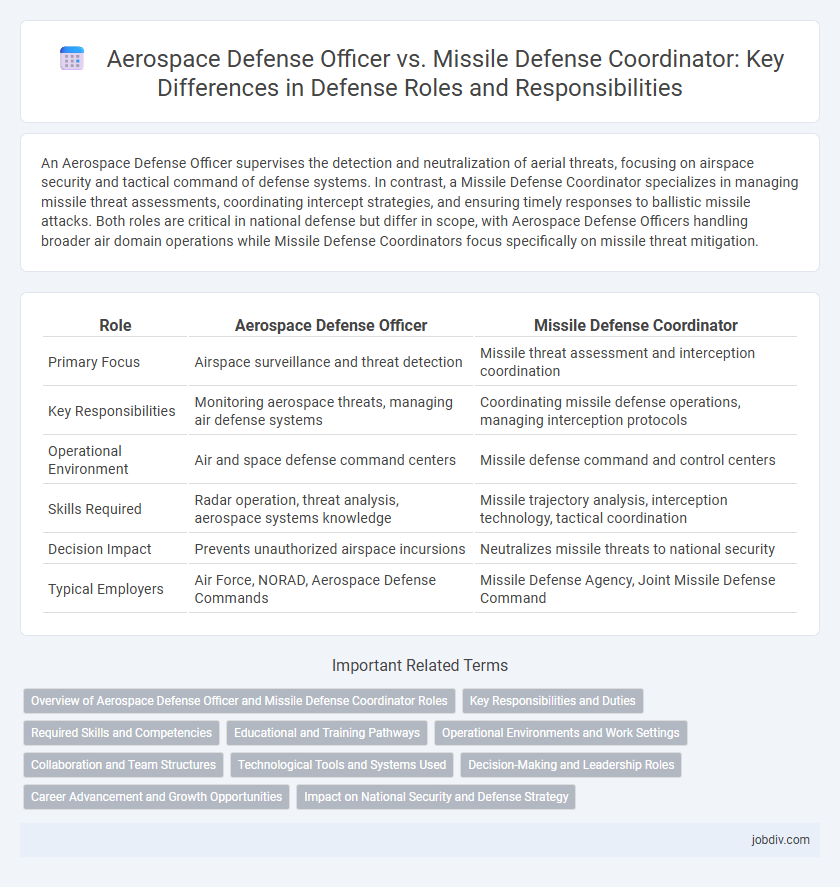An Aerospace Defense Officer supervises the detection and neutralization of aerial threats, focusing on airspace security and tactical command of defense systems. In contrast, a Missile Defense Coordinator specializes in managing missile threat assessments, coordinating intercept strategies, and ensuring timely responses to ballistic missile attacks. Both roles are critical in national defense but differ in scope, with Aerospace Defense Officers handling broader air domain operations while Missile Defense Coordinators focus specifically on missile threat mitigation.
Table of Comparison
| Role | Aerospace Defense Officer | Missile Defense Coordinator |
|---|---|---|
| Primary Focus | Airspace surveillance and threat detection | Missile threat assessment and interception coordination |
| Key Responsibilities | Monitoring aerospace threats, managing air defense systems | Coordinating missile defense operations, managing interception protocols |
| Operational Environment | Air and space defense command centers | Missile defense command and control centers |
| Skills Required | Radar operation, threat analysis, aerospace systems knowledge | Missile trajectory analysis, interception technology, tactical coordination |
| Decision Impact | Prevents unauthorized airspace incursions | Neutralizes missile threats to national security |
| Typical Employers | Air Force, NORAD, Aerospace Defense Commands | Missile Defense Agency, Joint Missile Defense Command |
Overview of Aerospace Defense Officer and Missile Defense Coordinator Roles
Aerospace Defense Officers are responsible for monitoring and securing airspace using radar and satellite technology to detect potential threats such as enemy aircraft and ballistic missiles. Missile Defense Coordinators specialize in managing missile defense systems, integrating tracking data and coordinating interception strategies to neutralize incoming missile attacks effectively. Both roles require expertise in defense technology and situational awareness to protect national security through proactive threat identification and response.
Key Responsibilities and Duties
An Aerospace Defense Officer oversees the detection, tracking, and neutralization of airborne threats, managing radar systems and coordinating air defense operations. A Missile Defense Coordinator specializes in the strategic planning and execution of missile threat assessments, prioritizing the deployment of interceptors and missile defense assets. Both roles require expertise in threat analysis, but the Aerospace Defense Officer focuses on airspace security, while the Missile Defense Coordinator emphasizes missile threat mitigation.
Required Skills and Competencies
Aerospace Defense Officers require advanced knowledge in airspace surveillance, threat assessment, and strategic command operations to effectively manage aerial threats and coordinate defense systems. Missile Defense Coordinators must possess specialized expertise in missile detection technologies, interception strategies, and real-time decision-making to counter ballistic missile threats accurately. Both roles demand strong analytical skills, situational awareness, and proficiency in command and control systems, but the Missile Defense Coordinator emphasizes rapid response capabilities and integration of missile tracking data.
Educational and Training Pathways
Aerospace Defense Officers typically pursue degrees in aerospace engineering, physics, or military science, complemented by extensive training in aircraft systems, radar operations, and strategic defense tactics. Missile Defense Coordinators often hold advanced degrees in missile technology, cybersecurity, or systems engineering, with specialized training in ballistic missile threat assessment, interceptor system management, and command-and-control protocols. Both roles require completion of military leadership programs and ongoing simulations to maintain readiness in high-stakes defense scenarios.
Operational Environments and Work Settings
Aerospace Defense Officers operate primarily in dynamic, multidomain operational environments that include air, space, and cyber domains, utilizing advanced radar and satellite systems to monitor and neutralize airborne threats. Missile Defense Coordinators focus on integrated missile threat environments, coordinating interagency responses and managing missile defense systems within command centers or joint operations facilities. Both roles demand a high level of situational awareness and expertise in real-time threat assessment, but Aerospace Defense Officers often engage in proactive surveillance, while Missile Defense Coordinators emphasize reactive interception strategies.
Collaboration and Team Structures
Aerospace Defense Officers and Missile Defense Coordinators operate within integrated team structures that emphasize real-time collaboration to protect airspace and missile trajectories. Aerospace Defense Officers manage radar systems and track aerial threats, while Missile Defense Coordinators focus on intercept strategies and missile deployment timing, ensuring synchronized threat response. Their seamless communication and data sharing optimize threat detection, decision-making, and coordinated defense execution across aerospace and missile defense domains.
Technological Tools and Systems Used
Aerospace Defense Officers utilize radar systems, satellite surveillance, and command and control software to monitor and secure air and space domains against threats. Missile Defense Coordinators rely heavily on missile tracking systems, interceptor technology, and integrated communication networks to detect, track, and neutralize incoming missile threats. Both roles require advanced use of real-time data analysis platforms and secure information-sharing systems to ensure rapid threat assessment and response.
Decision-Making and Leadership Roles
Aerospace Defense Officers lead strategic planning and operational command for air and space threat detection, emphasizing rapid decision-making to safeguard national airspace. Missile Defense Coordinators specialize in the integration and execution of missile defense systems, directing resources and personnel to intercept and neutralize missile threats effectively. Both roles demand decisive leadership and coordination across multiple defense sectors to ensure comprehensive protection against aerial and missile attacks.
Career Advancement and Growth Opportunities
Aerospace Defense Officers typically pursue leadership roles in strategic operations and advanced technology integration, benefiting from military training and experience in air and space defense systems. Missile Defense Coordinators specialize in project management and threat mitigation strategies, often advancing through expertise in missile technology and interagency coordination. Both career paths offer growth through advanced certifications, joint military exercises, and opportunities within defense agencies such as the U.S. Space Force and Missile Defense Agency.
Impact on National Security and Defense Strategy
An Aerospace Defense Officer plays a critical role in monitoring and protecting airspace, ensuring early detection and interception of airborne threats to maintain strategic air superiority. A Missile Defense Coordinator focuses on managing missile defense systems, optimizing threat response capabilities against ballistic and cruise missile attacks to safeguard national assets. Both positions are integral to a comprehensive defense strategy, with the officer enhancing airspace security while the coordinator fortifies missile threat mitigation, collectively strengthening national security.
Aerospace Defense Officer vs Missile Defense Coordinator Infographic

 jobdiv.com
jobdiv.com